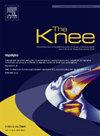长时间和短时间髌骨痛跑步者下肢生物力学的差异。
IF 2
4区 医学
Q3 ORTHOPEDICS
引用次数: 0
摘要
背景:探讨跑步者不同持续时间髌骨股痛(PFP)的下肢生物力学变化,为PFP的康复治疗提供依据。方法:我们招募了14名PFP持续时间超过12个月的休闲跑步者(长时间组),12名PFP持续时间小于3个月的跑步者(短时间组)和16名无PFP的跑步者(对照组)。收集了运行过程中的地标坐标和地面反作用力。采用单因素方差分析比较各组下肢生物力学性能。结果:与对照组相比,长时间PFP组表现出更大的膝关节外旋峰值角度(p = 0.010)和膝关节外展力矩(p)。结论:长时间PFP组在跑步过程中表现出更大的膝关节外旋角度、膝关节和髋关节外展力矩,而短时间PFP组在跑步过程中表现出更大的踝关节外翻。这些发现支持需要针对与PFP症状持续时间相关的不同生物力学特征量身定制特定时间的康复策略。本文章由计算机程序翻译,如有差异,请以英文原文为准。
Lower limb biomechanical differences in runners with long-duration and short-duration patellofemoral pain
Background
To investigate the biomechanical alterations in the lower limbs of runners with varying durations of patellofemoral pain (PFP) and provide a basis for the rehabilitation treatment of PFP.
Methods
We recruited 14 recreational runners with PFP lasting more than 12 months (long-duration group), 12 runners with PFP lasting less than 3 months (short-duration group), and 16 runners without PFP (control group). Landmark coordinates and ground reaction forces during running were collected. One-way ANOVA was performed to compare the lower limb biomechanics among the groups.
Results
Compared to the control group, the long-duration group demonstrated significantly greater peak knee external rotation angle (p = 0.010), knee abduction moment (p < 0.001), hip abduction moment (p = 0.007), and ankle external rotation moment (p = 0.004). The short-duration group showed significantly greater peak ankle eversion angle (p = 0.004) and ankle dorsiflexion–plantarflexion range of motion (p = 0.003) compared to the controls. No significant differences were found in peak vertical impact ground reaction forces (p = 0.906) or peak patellofemoral joint stress (p = 0.150) during the landing phase between runners with PFP and controls.
Conclusions
Runners with long-duration PFP exhibited greater external knee rotation angles, knee and hip abduction moments during running, while runners with shorter PFP duration showed greater ankle eversion. These findings support the need for duration-specific rehabilitation strategies tailored to the distinct biomechanical characteristics associated with PFP symptom duration.
求助全文
通过发布文献求助,成功后即可免费获取论文全文。
去求助
来源期刊

Knee
医学-外科
CiteScore
3.80
自引率
5.30%
发文量
171
审稿时长
6 months
期刊介绍:
The Knee is an international journal publishing studies on the clinical treatment and fundamental biomechanical characteristics of this joint. The aim of the journal is to provide a vehicle relevant to surgeons, biomedical engineers, imaging specialists, materials scientists, rehabilitation personnel and all those with an interest in the knee.
The topics covered include, but are not limited to:
• Anatomy, physiology, morphology and biochemistry;
• Biomechanical studies;
• Advances in the development of prosthetic, orthotic and augmentation devices;
• Imaging and diagnostic techniques;
• Pathology;
• Trauma;
• Surgery;
• Rehabilitation.
 求助内容:
求助内容: 应助结果提醒方式:
应助结果提醒方式:


